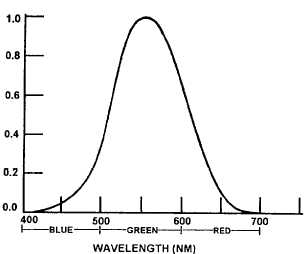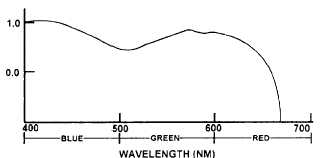Table 3-1.–Parallel Filter Bars
Filter Color and No.
Filter Color and No.
Deep Red
29
Bluish Green
65
Red
25
Bluish Green
65
Light Red
23A
Cyan
4
Orange
21
Cyan
44
Deep Yellow
15
Blue
47
Yellow
8
Deep Blue
47B
Yellowish Green
11
Violet
34A
Yellowish Green
13
Violet
34A
Green
58
Magenta
33
Green
61
Magenta
33
Use the parallel filter bars to choose contrast filters
for black-and-white photography. Adjacent filters
lighten colors next to them. Opposite filters darken
colors in the print; for example, a yellowish green No.
11 filter lightens subjects that are yellowish green or
yellow and darkens subjects that are violet. A No. 44
cyan filter lightens blue and blue-green and darkens
light red and orange.
Correction Filters
Although panchromatic film responds to all the
colors the eye can see, it does not reproduce tones of red,
green, and blue objects in the same relative values as the
eye sees them. The human eye is much more sensitive
to green than it is to blue and red, and these colors look
darker to the eye than green (fig. 3-2). Panchromatic
film is more sensitive to blue and violet and looks lighter
than green in a black-and-white print. This high
sensitivity to blue and violet causes an overexposure to
the film of blue objects as compared to green objects.
This overexposure causes a dense negative image that
Figure 3-2.–Color sensitivity of the average human eye.
results in a light print image (fig. 3-3).
A No. 8 yellow filter with panchromatic film helps
to reproduce colors of a daylight scene with the same
brightness relationship as seen by the human eye.
When using tungsten lighting, you can use a
yellowish green No. 11 filter to reproduce the natural
brightness relationship with panchromatic film. The
yellow in the filter absorbs the ultraviolet radiation and
some of the blue light, while the green in the filter
absorbs some of the red light.
Figure 3-3.–Color sensitivity of panchromatic film.
3-3





